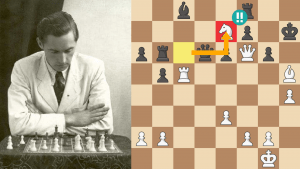
The Classic Bishop Sacrifice - Part 2
In Part One of this series, the main topic of the Bxh7+ thrust concerned the win of material. This might have been boring to some, but it is no less important than a full bore mating attack. Now, in Part Two, we’ll let the blood fly! Here we’ll explore what happens after 1.Bxh7+ Kxh7 2.Ng5+ Kg8 (2…Kh6 and 2…Kg6 will be discussed in later articles). I will also mention 1.Bxh7+ Kh8, which is usually an acceptance of doom since Black is then not only a pawn down, but his King has also been compromised! But, in rare instances, the 1…Kh8 refusal turns out to have merit.
Our first example starts off with a positional sacrifice:
Julius Kozma – Bogdan Sliwa, Zinnowitz 1967 [A40]
1.d4 e6 2.c4 Bb4+ 3.Nd2 d5 4.Ngf3 dxc4 5.a3 Bxd2+ 6.Bxd2 c6 7.e4 b5 8.b3 cxb3 9.Qxb3 Nf6 10.Bd3 Bb7 11.0-0
Though a pawn down, White has tremendous compensation for the pawn – two Bishops, a strong pawn center, a lead in development, and access to the various weak dark squares in black’s camp. Black’s next move is very natural (everyone knows that it’s not wise to leave your King in the center), and very bad.
11…0-0? 12.e5! Nd5 13.Bxh7+
At this point Black must have felt sick. He was well acquainted with this sacrifice, and was undoubtedly asking himself, “How did I allow this? How can this be happening to me?”
In the game, Black chopped the Bishop. But what if Black decided to refuse the offer? Let’s take a look.
13...Kh8
Now White has a wealth of riches. He can go for blood with 14.Ng5, or he can zip back to c2 (14.Bc2), intending to follow up with Ng5. Or he can play the more dramatic 14.Bg6. Since my readers crave drama, 14.Bg6 will be the move we look at!
14.Bg6
The threat is simply Ng5 followed by Qh3+.
14…fxg6
Black could play 14…Nf4 15.Bxf4 Qd5, but why bother? After 16.Qxd5 cxd5 17.Bd3 white’s a full piece up and already doing his victory dance. You do know that chess professionals always do a victory dance when their opponent’s resignation is imminent, don’t you? This is why chess is often viewed as equal parts game, science, and art – the combination of scientific exploration, combat, and dance makes it unique among sports.
15.Ng5 Rf5
Other choices are no less miserable:
* 15…Qxg5 16.Bxg5 and black’s two Knights stand no chance against white’s Queen.
* 15…Nf4 16.Bxf4 Rxf4 17.Qh3+ Kg8 18.Qh7+ Kf8 19.Nxe6+ is, to put it mildly, painful.
* 15…Re8 16.Qh3+ Kg8 17.Qh7+ Kf8 18.Qh8+ Ke7 19.Qxg7 mate.
16.Qh3+ Kg8 17.Qh7+ Kf8 and now almost everything blows Black off the board. I will settle for two stone cold wins:
18.Qh8+ Ke7 19.Qxg7+ Ke8 20.Qxg6+ Kd7 21.Qxe6+ Kc7 22.Ba5+ Nb6 23.Qxf5 and Black, who is an Exchange and three pawns down (not to mention white’s monster threat of Ne6+), should resign as quickly as possible and seek therapy.
18.Nxe6+ Ke7 19.Nxd8 Kxd8 20.Qxg6 and once again, resignation is the best option.
As you can see, the 13…Kh8 (refusal) option didn’t have much upside.
The Game Continuation: Black Has a Meal
13…Kxh7
Black gobbles a piece and snarls, “Come on! Show me what you got! Do your worst!”
14.Ng5+ Kg8
14…Kg6 is another story for another article.
15.Qh3
As usual, mate on h7 looms large.
15…Re8
It’s either this or giving up the Queen by 15…Qxg5 16.Bxg5.
16.Qh7+
In the actual game White decided to be subtle and played the inferior (but still winning) 16.Qh5, and he did indeed eventually get the full point on move 65. However, there was no need to avoid the usual slap on h7.
16…Kf8 17.Ne4!
Devastating. White intends to take away the black King’s running square on e7 by Bg5. Making e7 unwelcome to the sprinting black King is a major strategy in the Classic Bishop Sacrifice. Sometimes Bg5 achieves that goal, and sometimes placing the Bishop on the a3-f8 diagonal (Ba3 or Bb4) also has the same effect.
17…f6
* 17…f5 amounts to the same thing after 18.exf6 e.p.
* Trying to dash for freedom fails badly: 17…Ke7 18.Bg5+ f6 (18…Kd7 19.Nc5+ Kc7 20.Bxd8+ Rxd8 21.Qxg7 is completely hopeless) 19.Qxg7 mate.
* 17...c5 18.Bg5 f6 19.exf6 Nxf6 (19…gxf6 20.Bh6 mate) 20.Nxf6 Qxf6 (20…gxf6 21.Bh6 mate) 21.Bxf6 gxf6 22.Qxb7 is gruesome.
18.exf6 Nxf6 19.Bb4+
Switching to the a3-f8 diagonal!
19…Re7
More abrupt is 19…Kf7 20.Ng5 mate.
20.Nxf6 Kf7
20…gxf6 21.Qh8+ Kf7 22.Qxd8, 1-0.
21.Nh5 Qf8 22.Bxe7 Kxe7 23.Nxg7 Bc8 24.Rfe1 and White, who is an Exchange and a pawn up, also has an overwhelming attack against the enemy King.
What we saw here is that, after the Bxh7+ sacrifice:
* Refusal by …Kh8 is a hopeless proposition if White still retains a powerful attack.
* Taking the Bishop and then retreating to g8 usually results in the White Queen penetrating to h7 when f7 and g7 often also fall as the beleaguered King desperately tries to avoid being mated.
* When the King eats the Bishop and then tries to run for its life, the e7-square is often extremely important. If White can deny the King access to that square (via Bg5 or placing the Bishop on the a3-f8 diagonal), then the defense is usually going to crash and burn.
Since the “refusal defense” by …Kh8 didn’t look very appealing in our first example, let’s look at a couple situations where it makes a bit more sense.
In this tense position White took over the game with 18.Bxh7+ (Anything else would be quite nice for Black), when Black replied with 18…Kh8. Though the position after 18…Kh8 is bad for Black, taking would be far worse:
18...Kxh7 19.Ng5+ Kg8 20.Qh4 Re8 21.Qh7+ Kf8 22.Qh5 Kg8
* 22…Qxg5 is best but completely hopeless.
* 22…g6 23.Qh8+ Ke7 24.Qf6+ Kf8 25.Qxf7 mate.
* Both 22…Qe7 and 22…Re7 deprive their King of the e7-square, which allows 23.Qh8 mate.
23.Qxf7+ Kh8 24.Qh5+ Kg8 25.Qh7+ Kf8 26.Qh8+ Ke7 27.Qxg7 mate. This mating pattern, with the King on e7 being mated by white’s Queen on g7, is very common and thus important to remember.
Declining the Piece
In the game Capablanca went wrong with 19.c3?! Bb5 20.Rfe1? (20.Ng5! Bxe2 21.Qh4 Qxg5 22.Qxg5 Kxh7 23.cxb4 axb4 24.Rc1 Bxf1 25.Kxf1 Kg8 and Black can still put up stiff resistance, though he'll most likely lose in the end.) when Black could have jumped right back in the game with 20…Kxh7! 21.Ng5+ Kg6 22.h4 Nd3 23.Rxd3 Bxd3 24.Qg3 Kh6 25.Qxd3 g6 26.Nf4 Qe8.
19...g6
19…Kxh7?? runs into that classic (and very important!) mating pattern mentioned earlier: 20.Qh5+ Kg8 21.Ng5 Re8 22.Qxf7+ Kh8 23.Qh5+ Kg8 24.Qh7+ Kf8 25.Qh8+ Ke7 26.Qxg7 mate.
20.Ng5 Nc6
20…Be7 21.Bxg6 Kg7 22.Nxf7 Rxf7 23.Bxf7+ Kxf7 24.Qh5+ Kg7 25.Rd4 Rc4 26.Rxc4 dxc4 27.Rd1 and Black won’t survive.
21.Bxg6! Nxe5 22.Qh4+ Kg7 23.Bd3 Rg8
23…Rh8 24.Qg3 Ng6 25.Nxf7 wins.
24.Nf4 Kf8 25.Nh7+ Kg7
25…Ke8 26.Nf6+ Kf8 27.Qh6+ Ke7 28.Bh7 and black’s completely busted since there’s just too much heat raining down on his King. An example: 28…Rf8 29.Rfe1 Kd6 (29…Bd6 30.N4xd5+ exd5 31.Nxd5+ Ke8 32.Qxd6 is a bloodbath) 30.Rxe5! Kxe5 31.Rxd5+ exd5 32.Nxd7+ Qxd7 33.Nd3+ Kd4 34.Qf4 mate! Good times!
26.Nh5+ Kh8 27.Qf4
And not 27.N5f6?? Nf3+ and Black wins!
27…Ng4 28.h3 e5 29.Qxf7 Be8 30.Qf5 Bg6 31.Ng5! Bxf5 32.Nf7+ Kh7 33.Bxf5+ Rg6 34.Nxd8, 1-0.
This example showed us:
* One of the most common and useful mating patterns in the CBS, which features the enemy King frozen on e7 and the White Queen on g7 claiming immediate mate. Remember it!
* That refusing the sacrifice is sometimes the right thing to do, but the King can still fall victim to a bloodthirsty attack.
* These attacks are often fun, brutal, and exciting. However, the attacker needs to play with lots of energy, while the defender can sometimes hang on if he has ice-water in his veins (in other words, he laughs in the face of the attack).
Our next example shows us that sometimes the sacrifice isn’t necessary or decisive, but if you want to give it a try and have fun, then why not go for it?
It doesn’t take a genius to just recapture the Knight by 12.bxc3 with a good attacking position. But one has to admit that snapping on h7 is very, very tempting. So tempting, in fact, that the late international master Viacheslav Osnos couldn’t resist!
There is a lot to learn here about key patterns in the CBS, so go over all the notes in this game several times until you have a firm grasp of these concepts.
12.Bxh7+ Kh8
A draw results after 12...Kxh7 13.Ng5+ Kg8 14.Qh5 Re8 15.Qxf7+ Kh8 and White has no decisive continuation. However, even though black’s f6-Bishop is holding body and soul together, Black has more pieces in play than White, and black is two pieces up, the attack comes close to working anyway! 16.bxc3 (This gives White the possibility of a4 followed by Ba3, which is a device I mentioned earlier that’s designed to take away the e7-square from black’s King. It also threatens 17.h5. The immediate 16.h5?? walks right into 16…Ne5! when 17.dxe5 Qd1 mate has the wrong guy getting mated! After 16…Ne5 White would have to try 17.bxc3 Nxf7 18.Nxf7+ Kg8 but Black ends up with an extra piece and an easy win.) 16...e5! (Counterattacking in the center and also freeing the c8-Bishop. 16…Qd7?? loses to an idea we’ve seen before: 17.Qh5+ Kg8 18.a4! and the threat of Ba3 is decisive: 17…Bxg5 18.hxg5 Ne7 19.g6 Nxg6 20.Qxg6 and suddenly White is up a pawn and still has a raging attack!) 17.Qh5+ Kg8 18.Qf7+, draw by perpetual check.
13.bxc3! Nxd4!!
At first glance this doesn’t make any sense, but a deeper look shows us that Black is making use of the “place a black Queen or Bishop along the b1-h7 diagonal and guard h7 defense.” I guess a snappier name for the maneuver is simply, “the b1-h7 diagonal defense.”
In the actual game Black cracked under the pressure: 13…Qa5? 14.Be4! Kg8 15.Bd2 Rd8 16.Ng5 g6 17.Qf3 Kg7 18.Nxf7 Rf8 19.Bh6+ Kxf7 20.Bxc6 bxc6 21.Bxf8 Ba6 22.Bd6 Kg7 23.Qe3 c5 24.Be5 Rf8 25.dxc5 Rb8 26.Rd1 Rb2 27.Bxf6+ Kxf6 28.Qg5+, 1-0.
14.cxd4
14.Ng5 Nf5! 15.Qh5 Bxc3+ 16.Ke2 Nh6 17.Nxf7+ Rxf7 18.Bxh6 Rxf2+ 19.Kxf2 gxh6 20.Qxh6 (20.Be4 Qf6+ 21.Ke2 Bxa1 is fine for Black) 20…Qd4+ 21.Ke2 (21.Kg3 Bd2!) 21…Qg4+ 22.Kd3 Qg3+, =. Hardly a full analysis – lots of fun stuff to analyze here if you have the inclination to do so.
14…Kxh7 15.Ng5+ Kg8 16.Qh5 Qa5+
The point of 13…Nxd4!
17.Bd2 Qf5 and Black is fine since h7 is firmly defended.
An important example that showed us:
* That these attacks can be dangerous even if various White factors are far from optimal.
* Even if the sacrifice isn’t analytically decisive it still is fun and, against a poor defender, effective.
* More proof that getting white’s dark-squared Bishop on the a3-f8 diagonal is a major part of white’s CBS repertoire.
* The “b1-h7 diagonal defense” is a huge defensive concept!
Okay, now you’re armed and dangerous with various CBS patterns. Time to test yourself in our puzzle section.
The first four puzzles are unusual in that I’m looking for a “verbal” answer. The solutions to these can be found at the end of the article.
Puzzle One: White did the usual Bishop sacrifice and Black decided not to take it, instead opting for 9…Kh8. Does this leave Black with any hope?
Puzzle Two: Does 22.Bxh7+ work here?
Puzzle Three: White played the surprising 14.e6. After 14…dxe6 is Black winning, better, equal, worse, or losing if White goes for it with 15.Bxh7+?






